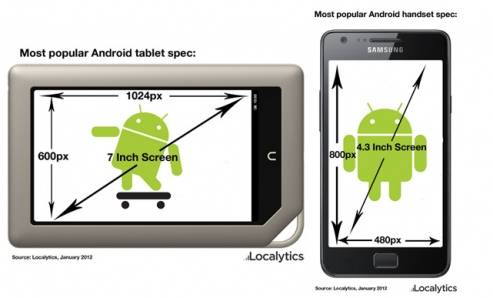
If you’re reading this on your Android phone, odds are pretty good that it’s running Gingerbread and has a screen four inches or larger with a resolution of 800×480. That’s the conclusion reached by Localytics, a research firm taking a long hard look at data supplied by apps that use the company’s proprietary analytic data. Localytics claims that a full 73% of Android devices (smartphone and tablets) run Gingerbread. That figure disagrees with the latest numbers from Google, now a month old, which claim that Gingerbread runs on just 55% of Android hardware.
Using the data collected, Localytics created a picture of an “average” Android smartphone. Based on their research, the most popular spec is a Gingerbread phone with a 4.3-inch screen and a resolution of 800×480. This description matches a handful of Samsung and HTC models currently being sold. 4.3-inch phones accounted for more than 40% of all devices, with 4.0 inches, 3.2 inches and 3.7 inches following at 22%, 11% and 9%, respectively. Screen resolutions are more dramatically divided, with 800×480 taking 62% of the pie, followed by 480×320 at 14%, 960×540 (qHD) at 6%, and 480×854 (a popular Motorola res) and 320×240 at 5% each.
The average tablet isn’t really surprising: it’s a 7-inch device with a 1024×600 screen. A whopping 74% of Android tablets use that size and resolution, first introduced with the original Samsung Galaxy Tab and Nook Color. Just 22% use the 10.1-inch ,1280×800 size popular among current Samsung, Acer, Lenovo and Asus tablets. 71% of tablets use Gingerbread, with just 21% using the various releases of Honeycomb. Clearly, small, cheap tablets are winning the game as far as Android sales are concerned.
These numbers shouldn’t be taken as gospel – Google will probably update its distribution statistics in the next few days.
[via 9to5 Google]










The fragmentation thing was always an invented problem with no basis in
truth – the very opposite in fact. But they got three years of gloom
and doom in the press about it. The stories started appearing in
February of 2009, believe it or not.
It’s nice to see some
analysts trying to claw back some vestige of their credibility, now that
this perceived fatal problem has not prevented the Android ecosystem
from growing to hundreds of millions of unit sales per year, giving developers a vast market to sell into that they can select significant fractions of if they prefer.